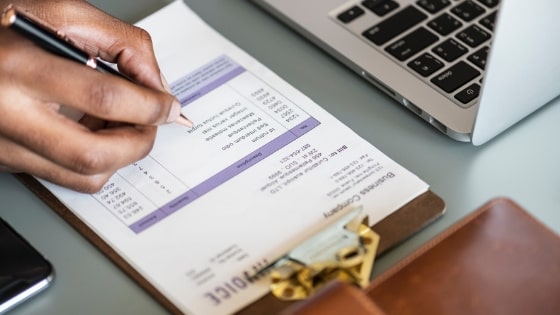
Filing Your Taxes Doesn’t Have to be Intimidating
Tax season can be a stressful time for anyone.There’s a lot to think about, from ensuring you file on time to making sure you included all the information you needed to. While you know about taxes in general, you may not be sure how the income tax process actually works. Here’s what you need to know and how you can use this year’s refund to invest in your future.
Feb 12, 2019
6 min read
Do you look forward to tax season? If you’re not an independent contractor, freelancer, or self-employed, you probably do. Though filing the appropriate paperwork and ensuring you’ve submitted everything by April 15th can be stressful, the tax refund you receive is something you rely on to catch up on bills, invest in school, and take care of whatever odds and ends you haven’t been able to afford until now. While you know when you need to file your taxes and who you should go to to get it done, you might not be sure how taxes work. Tax code is pretty complicated, but here are a few things everyone should know.
Learn the Basics of Filing Taxes
Tax season can be frustrating, annoying, and even intimidating. There seems to be so much room to make a mistake, a million rules you’re not quite sure of, and piles of forms labelled with numbers and letters. But filing your tax return correctly and on time doesn’t have to cause you anxiety. Knowing more about the process can help!
Where the process begins.

Income tax begins when you start your first job. On day one, you fill out a stack of paperwork before training begins. Most of that will be human resources required disclosures and agreements, but one of the most important parts will be the W-4.
The W-4 collects the info needed to calculate how much your employer will hold back from each paycheck for income taxes. If you’re single or married, if you have children or dependents, and whether or not your spouse works all go into determining how much you should be taxed each year.
Then, each paycheck, the amount your employer holds back from your pay is sent to the government. Filing a tax return is a way to ensure you paid the right amount in withheld income to the government. If you paid too much, which is often the case for most people, you’ll receive a “refund.” If you didn’t have enough taken out, you’ll owe the balance, which needs to be paid by you directly to the Internal Revenue Service (IRS).
For independent contractors, freelancers, and those who are self-employed, it can get a lot more complicated to determine how much the IRS charges you. There are different forms to be filled out and different rules, which almost always require the assistance of an accountant or tax professional.
How the amount you need to pay is determined by the IRS.

There are a lot of factors that go into determining what you need to pay in taxes. For the most part, you’re taxed based on the “tax bracket” you fall under. The more you make, the higher your tax rate is. Though tax brackets can vary from year to year, generally, the lowest tax bracket is charged 10% of their taxable income, while the highest is taxed around 37%.
The brackets also depend on your filing status. While you’ll still see brackets broken down from taxing 10% to 37% of your income, the amount of taxable income that places you in a certain bracket is different. For example, you could earn between $0 and $9,525 after eligible deductions and be in the lowest tax bracket as a single person, meaning you will be taxed 10% of that income.
If you file your taxes as the head of your household, meaning you are claiming eligible dependents, the amount of taxable income that qualifies you to be in that lowest bracket goes up a bit. To be taxed 10% as the head of household, you can make up to $13,600 of taxable income.
What’s taxable income?

Taxable income is the amount of money you make during the year after any tax deductions or credits that you’re eligible for are applied. Tax deductions are subtracted from your income. Then, what’s left is the amount of money that can be taxed.
There are several different types of tax deductions, from giving to charitable causes, adding to retirement funds, and more that affect your taxable income. On top of tax deductions, you may also be eligible for certain tax credits.
A tax credit differs from a deduction in that the credit reduces income tax you owe. So, say you’d owe $500 but are eligible for a credit that reduces that tax by $450. You’d then only be responsible for paying $50 to the IRS.
Make sure you have the right documents to file your tax return.

No matter which tax bracket you fall in, filing your income tax return can be confusing. There are so many boxes to check, so many things to get right, and big consequences if you get them wrong, that sitting down to add and subtract your life from the previous year can make you want to scream.
To make sure the process is as smooth as possible, you want to have everything you need in front of you before you get started. Start with gathering the basic documents you know you’ll need. That includes
- Your social security number, if you don’t have it memorized
- If you’re married and filing with your partner, have their information ready, too
- Same goes for any dependents you’re claiming
- Income documents such as your W-2 from your employer
- If you’re unemployed or self-employed, you’ll need a different set of forms to correctly file your taxes
If your income and deductions are relatively straightforward, an easy-to-use tax preparation website like TaxAct or TurboTax can walk you through the steps of filing your tax return online. However, if you’ve had some big life changes, aren’t sure what you should claim on your return, or just want to make sure you have everything 110% correct, it’s a good idea to see an accountant or tax preparer.
Making the most of your tax refund.
Do you have plans for your tax refund? Most people do! From purchasing something that you’ve needed for a while to treating yourself to something fun, you probably know where your money is going when it hits your bank account. One great way to make the most of your return is to invest in your future by finishing or furthering your education. If earning your high school diploma has been on your mind or you want to change careers from being an administrative assistant to becoming a veterinary technician, setting aside some of your tax money to put toward reaching your goals helps. With Penn Foster’s online, flexible, and affordable courses, you can get the most out of your tax time investment. Have questions about our programs? Chat with an Admissions Specialist today at 1.800.275.4410!




